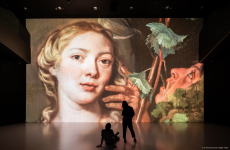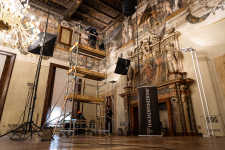While the museum remains closed due to Covid-19 restrictions, Haltadefinizone has been chosen to perform digital image capture on more than fifty paintings in its collection, including The Rape of the Sabine Women by Giambologna and paintings by Lorenzo Monaco, Pietro Perugino, Filippino Lippi, Sandro Botticelli, Pontormo, Bronzino, Allori and many others.
This extraordinary digital imaging project has two goals: to monitor the present state of conservation of the works and to allow the public to enjoy access them in a new way. There will be new pages on the Galleria’s website to display the paintings in ultra-high definition, with innovative tools for teaching and learning at a distance, making it a virtual museum.
The first part of the project is a close, careful study of the paintings and sculptures and a light dusting, where necessary, using a portable examining frame and with the assistance of the Gallery’s logistics staff. Digital photography is scheduled over the next few weeks. The Gallery staff will supervise it, to deal with the practical challenges of handling the works, in order to take the best possible care of them. For example, think of the collection of Gypsum sculptures or of important paintings that are kept in climate-controlled frames.
“The project began on an experimental basis in August of 2019 with the digital acquisition of the altarpiece of Andrea Orcagna, which was under restoration at the time,” says Cecille Hollberg, director of the Galleria dell’Accademia di Firenze. “It continues with the digital acquisition of more than fifty great works in the collection, including large altarpieces by Perugino, Bronzino and Allori in priceless gold leaf and a selection of musical instruments. There are also sculptures in gesso and the unfired clay model of the Rape of the Sabine Women by Giambologna. Over the next few weeks, the public will be able to follow the progress of the digitalization project on our website. Soon after that is finished, the Galleria’s website will have a new section dedicated to close-up viewing of the masterpieces in our collection.”



